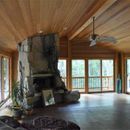How to create an air seal
我们最近买了一个房子,一个房间cathedral ceiling covered on the inside with cedar siding. This room, which was an addition has its own electric forced air furnace. Unfortunately, the builder of this room did not install a air barrier or even drywall under the siding, but did insulate the cavity above. This allows the thin cedar to leak at all of the joints. Blower door test and smoke confirmed the leakage.
I see two alternatives:
1. Remove the roof deck and apply spray foam from above, install a new deck and roof.
2. Remove all of the interior siding, insulate and apply a vapor/air barrier and reinstall the cedar. Unfortunately, I do not know how much cedar would be scrapped with damage from removal in the process.
Short of removing the roof deck or all of the siding, is there a way to seal this surface with either a clear spray or possibly caulk all of the lap and butt joints with a clear caulk?
GBA Detail Library
A collection of one thousand construction details organized by climate and house part











Replies
I should have included this home is in Southeast Michigan.
What kind of insulation, and what kind of roof are there now?
The option of trying to air seal it from the inside, although theoretically possible, sounds very unlikely to work well. You'd need a resilient caulk in each joint to survive expansion and contraction with changes in humidity, and getting that done well is very difficult and unlikely; getting it done well and still looking good even more unlikely.
If you take it apart from the top, there are probably greener options than spray foam, but I'll wait on recommending anything specific until I hear more about what's there now.
Cheaper than pulling the roof deck off to spray foam in the cavities, seal any soffit to ridge venting (details depend on how the roof deck is actually vented) and remove only the roofing. Dense-pack the rafter bays with cellulose drilling in from the exterior, then use a self-healing peel'n'stick membrane to air seal the roof deck from above. Then (and this is important), install rigid foam above the roof deck of an R value equal to at least 67% of what's in the cavity.
eg: Say you have 2x10 rafters, currently insulated with R30 batts. Dense-packing over them will raise the R-value of the cavity to about R35-R36. To keep the average temp at the roof deck warm enough to avoid excessive wintertime moisture accumulation from interior moisture drives in your climate zone requires at least 0.67 x R36= R24 of insulation above the roof deck. If that foam is rigid polyiso, at the labeled R6/inch it would be nominally R64" if using the labeled rated R, but it should be derated to R5/inch for these purposes. That means 5" would be enough to get you there, but 6" would be better.
The foam can be held in place with a half-inch CDX or OSB sheathing nailer deck through screwed to the rafters with pancake head timber screws. On the nailer deck use standard underlayments for your roofing options.
You'll need to adust the chimney flashing and apply a facia board cover the end of the foam layer to accommodate the extra roof thickness.
The end result is an air-tight better-than code roof that is far less prone to ice dams, etc., even if the rafters are only 2x6 (as long as you install at least 5-6" of polyiso above.)
Those recessed lighting fixtures may not be insulation contact rated, and are almost certainly not air-tight, especially when mounted on t & g cedar. Replacing them with surface mount fixtures and air sealing it (to the best possible) with expanding foam may be necessary, as is sealing the electrical box serving the ceiling fan.
Dan,
There is no way to seal the leaks in your ceiling with caulk or some type of liquid finish.
When this issue has come up in the past, A.J. Builder (a GBA reader who posts comments) advised that it's possible to remove ceiling boards like yours and reinstall them without much damage. However, be aware that it's hard to predict whether the boards will come off easily. Ring-shank nails are more tenacious than smooth-shank nails, so the type of fastener used, and the length of the fasteners, can make a big difference.
One option you didn't mention is to demolish enough of the existing ceiling to gain access to the rafter bays; insulate with spray foam; and then install a new ceiling (either drywall or new boards).
Dana's method is a good one, of course.
I helped with a job that involved removal of the roof sheathing; installation of spray foam from above; reinstallation of the roof sheathing; and new roofing. As long as the weather cooperates -- it did for the job I was involved with -- this approach works.